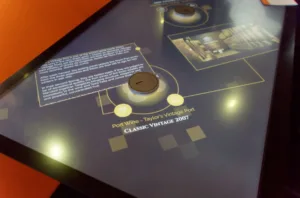 AG Neovo was showing a new 55″ dual sided LCD totem design for indoor use. The unit has an empty base which can be used for a driving PC or system.The company can also supply an Android or Linux-based media player. The company also highlighted its 75″ and 98″ UltraHD displays. There was nothing new on the desktop monitor side, the company told us.
AG Neovo was showing a new 55″ dual sided LCD totem design for indoor use. The unit has an empty base which can be used for a driving PC or system.The company can also supply an Android or Linux-based media player. The company also highlighted its 75″ and 98″ UltraHD displays. There was nothing new on the desktop monitor side, the company told us.
Asus told us at BETT that it planned to promote its larger displays more strongly and the company was at ISE, as it was last year. However, much of the emphasis was on client devices including Chrome devices. The CS10 is billed as the world’s smallest Chrome OS device. It can be used to make a TV ‘smart’ using a connection via USB. The processor is a RockChip 3288-C with Arm Mali T764 GPU and has 2GB of RAM and 16GB of storage. The Chrome browser can be used to browse the web.
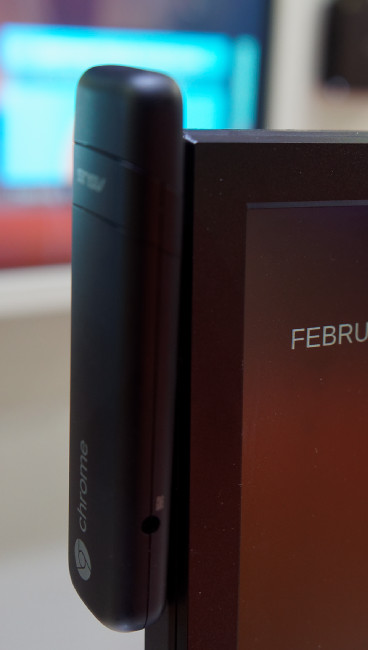 The Asus ChromeBit. Image:MekoThe company has supplied its ChromeBox 2 to power a car configurator developed for Toyota. The box uses Intel Core CPUs or Celeron.
The Asus ChromeBit. Image:MekoThe company has supplied its ChromeBox 2 to power a car configurator developed for Toyota. The box uses Intel Core CPUs or Celeron.
We then looked at the new USB-Type C powered monitor, the MB16AC that is a 15.6″ FullHD monitor that runs from a USB Type-A or Type C port and is just 8mm thick. Weight is 800 gms.
AUO had a set-up in a hotel near the RAI where it was meeting clients. First we looked at a VA 27″ FullHD panel with wide colour gamut, quoted at 90% of NTSC and brightness is 350 cd/m². The company sees applications including gaming machines. The wider gamut doesn’t meet a particular specification but is wanted by those in gaming.
The next panel we looked at was a 21.5″ FullHD panel for signage and transport applications and with brightness of 1,500 cd/m² and contrast of 1,000:1. Power consumption is 61.3W and gamut is 72% of NTSC.
A 42″ VA panel with FullHD was fitted with metal mesh to support PCap touch operation (10 point) and produces 400 cd/m² or output. The panel has a 3H AG surface and can be up to 6mm with just two touches. The touch panel can be air- or optically-bonded.
AUO is developing a range of displays with 700 cd/m² and UltraHD resolution and optimised for operating theatre use. The units, in 43″, 55″, 65″ and 75″ will be available in Q2.
Finally, we looked at a new ENB panel that has a 2.2mm pixel distance. AUO told us that, whatever the bezel, all the three main suppliers of ENB panels (AUO, LG & Samsung) have a pixel to pixel distance of 2.2mm. AUO said that it can supply either panels or complete monitors which are pre-calibrated to allow them to look good as soon as they are installed.
Baanto was focusing on its modular approach for touch-enabled large single and video wall displays. The company showed us that it has improved the accuracy of its shadow-based touch which can help, especially in areas such as Asia where the width of the strokes of characters is important and can be very fine.
We reported on the BrightSign series 3 release from the Midwich event last year, so the main news for us was of a new Brightsign OPS media player, which is a Series 3 player in an OPS module. The unit, the HO523, supports up to 1080P60 and features include Bluetooth/Beacon communication and display synchronisation. Perhaps the biggest news, though is the price. The module is available at $399 which makes it a good option for integrators that know and like the BrightSign range. The company was also promoting its ‘BrightSign Built-in’ module that offers the same performance and support, but is designed to be integrated by OEMs. For example, it could be built into a meeting room display. The power consumption is low enough that a complete display and controller can be run using PoE technology.
 Brightsign’s OPS player costs $400. Image:Meko
Brightsign’s OPS player costs $400. Image:Meko
On the Coretronic booth, the company was showing its pico-projection technology which is being used by OEM partners who are developing near-to-eye systems. One on display was the MadGaze X5 (http://madgaze.com/x5/) which is based on Android 6.0 and supports 800 x 480 resolution. The system uses a 1.3GHz quad core CPU, 2GB of RAM and 32GB of storage. The camera is an 8MP version and there are six controls. The system can support playback of 1080P content and the battery has a capacity of 500mAh. The quality of the image in the A/R display looked pretty good to us.
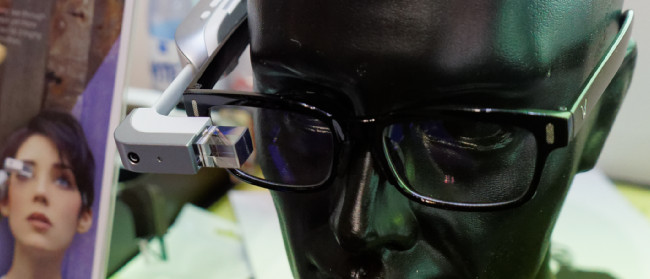 The MadGaze AR display uses a Coretronics engine. Image:Meko
The MadGaze AR display uses a Coretronics engine. Image:Meko
DeepSky of Hong Kong was one of the most interesting of the new small pitch COB LED displays that we saw last year, but this time there wasn’t a lot of progress on production. The company has had a number of design wins for its 0.9mm pitch display and they include Dior in New York which has 7.5m2. The next version that the company is making will use a new generation of LED controllers and will be available in Q2. It is said to support up to 4,000 cd/m² of brightness, even on the small pitch of 0.9mm, making LEDs suitable for HDR applications.
DisplayNote was highlighting its latest screen sharing software, Montage which allows up to 12 devices (PC/Android or MacOS) to connect to a single screen. Annotations are persistent and content sharing is supported.
The company is working on a new product Mosaic, a collaboration application designed for multi-site use, with multiple displays and clients with a full office stack for editing Office documents and that will be available at the end of Q2. The collaboration suite has features including video annotation and document sharing as well as support for video conferencing. The application will be bundled with NEC’s Infinity Board displays.
Displax of Portugal was at the show with its metal-mesh based PCap technology. The company was highlighting that it solution is a complete one, including software as well as the special patterns that it has. On the booth, the company had a table demonstration that used objects with specific patterns on the base and which could be recognised for interactive table applications. The company can support display surfaces from 32″ to 105″.
brThe Displax Touch table can recognise objects. Image:Meko
Dynascan always has an impressive presentation because of the high brightness of its displays. It was showing its latest 800 cd/m² DI651ST2 fanless FullHD display. The panel is weatherproof and dustproof to IP5X and uses an IPS panel to give a blackening defect free temperature of 110 degrees C. There is also a 55″ version of this monitor with 1,000 cd/m² of brightness. The company was also showing a 55″ FullHD panel that is double sided, with 3,000 cd/m² from one side and 1,000 cd/m² on the other for shop front applications where the 3,000 side would be shown to the outside.
Also new was a 4,000 cd/m² 75″ (also in 55″), the D0751LT5 for outdoor use and with an IPS FullHD panel. It will be available in Q3, so some technical details are still to be decided, with weather resistance to IP56. The monitor can be vandal protected and Dynascan told us that it can supply up to 7,000 cd/m² if required by customers.

FlatFrog had a booth in the main collaboration area and had displays and helpers from a number of partners including Dell. The company was showing the range of different solutions using its technology. At BETT, we spotted five companies with the firm’s optical touch technology, but this was up to, we were told, around twenty companies at ISE (14 are listed on the firm’s website). The firm is trying to move beyond its starting point with the TIR touch that it initially developed and is now offering full monitors in sizes from 23″ to 86″ as well as add-on modules from 23″ to 65″. The company’s technology is also now available as a clip-on module from Prestop.
The firm was showing its latest concepts for ‘intuitive collaboration experiences’ and said that it wants to ‘redefine the KPIs for collaboration’ to support multi-user very well.
Holovis had an area devoted to demonstrations of its V/R ‘experiences’. One was called the ‘Near Death’ experience and involved a viewer using a VR headset and, apparently going up in a lift (the floor vibrated) to the top of a building (at this point a fan was brought into play. We didn’t try it, but those that did reported that they found it surprisingly engaging! The displays used were standard Vive/Rift units.
Hyundai IT used to make some of its special touch displays and totems in Germany, but these days just has a sales office in Germany. The company had a 75″ outside LCD with a direct backlight and 3,000 cd/m² of output being shown outside one of the show entrance gates. The display is certified to IP65. The company is interested in talking to partners and distributors for its products. As well as the high brightness displays, there were some touch displays and in the future the company plans to offer optically bonded units. At the moment, a PVA panel is used, but in the future an 86″ IPS unit will be offered. Also on show were 55″ narrow bezel video wall LCDs with 1.8mm bezels.
Iadea is a maker of media players. Our attention was drawn to the company by its displays which were shown with the AUO logo, but this was just an exhibition sponsorship between the two companies. Iadea has Android-based media players and can support ‘good quality’ UltraHD performance and high resolution tiling of different displays. It can support arbitrary display configurations and ‘infinte video walls’.
 Iadea Media collaborated with AUO. Image:Meko
Iadea Media collaborated with AUO. Image:Meko
Iiyama is enjoying life at the moment. The company has been moving away from promoting its touch display just in retail to also promote itself in collaboration and meeting rooms. It has 65″ PCap displays (UltraHD/25/7 L/P) which are claimed to have high performance (partly a consequence of the Sharp controllers used, which the company rates highly) and has been selling its 86″ well. Staff on the booth told us that it has sold some to a corporate in France that has not yet realised that they support touch operation as well as simply showing UltraHD content. “Just think how pleased and surprised they will be”, staff said.
Intel was at the show with a booth to highlight and promote its Unite platform which was launched at Infocomm last year and is gathering support. The platform has been developed to go beyond Wi-Di to allow the integration of serious security that can make collaboration more acceptable to corporates and large enterprises. The system installs a SQL server on the PC that is connected to a collaboration display and every meeting is allocated a PIN by the system. Collaborators can access the meeting using the PIN and Intel has clients for Windows, Android and MacOS, with ChromeOS available in a couple of months. Connections to the host PC are by Wi-Fi Direct, without going through the corporate network. Remote users can login using WebRTC and the system supports 1080P30 video. The Unite platform is an open platform with an API and SDK, allowing for custom meeting applications to be developed. Services such as Skype for Business, GotoMeeting etc are supported by plug-ins and other guest plug-ins can be accomodated.
Intel, of course, owns Mcafee and so security is assured and when the last user leaves a meeting, it is fully secured. Other features include meeting room lighting control and even the use of analytics via a telemetry plug-in that can report meeting room use and occupancy etc. The SDK and API are supplied to OEMs and partners (not to users) at no cost. There are specific features that support Intel’s VPro CPUs and the firm told us that it has had requests to work via OPS.
At the moment, the system only supports a single meeting room display, but a multiroom upgrade is ‘on the roadmap’ for later in 2017. As well as the collaboration mode, there is a presentation mode which allows a moderator to control which client has access to the display and a kiosk mode so that the display can be used for wayfinding or to display information and news when now meeting is taking place.
Intopix is the developer of the Tico codec but was highlighting its cores for JPEG2000 ULL (Ultra Low Latency). This is intended to support applications that need latency of less than 10ms when encoding. The codec can be used to transmit 4K60 4:4:4 HDR video over 1GB Ethernet (and Crestron announced at ISE that it was using the Intopix core in a new product). We also looked at the company’s latest Tico codec which is being used by Icron to make a USB+DisplayPort 1.2 extender that uses 4:1 Tico encoding and can run over standard 10GB ethernet switches.
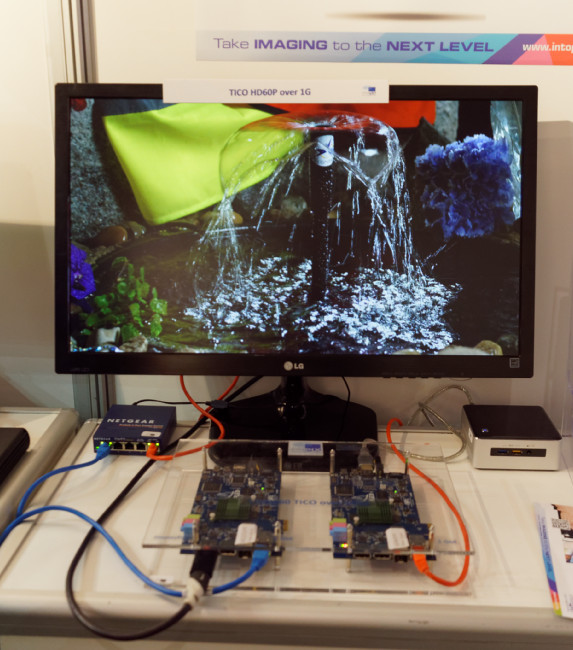
Keewin was showing its outdoor and high brightness displays. There was a 55″ FullHD air cooled unit with 2,500 cd/m² of output and 420W of power consumption in a totem for outdoor use. Another interesting display was a double sided totem, with 2,500 cd/m² on one side and 700 cd/m² on the other, allowing it to be used in situations where one side is in daylight, but the other is more protected. The 55″ FullHD unit had 600W power consumption and thickness is just 80mm.
Konka has added to the range that it showed at last year’s show. New were 70″ and 84″ interactive displays, which were a focus this time. As well as these infrared-based products, the firm was showing 55″ and 65″ PCap monitors.
KTC was at the show, as it has been since 2010, to talk to its OEM customers, as it doesn’t sell displays under its own brand. New this year were 75″ and 86″ UltraHD touch displays based on IPS panels and with 410 cd/m² of output and a 65″ FullHD PCap unit with 350 cd/m² of brightness and also with an LCD from LG. The company told us that it is able to buy open cell displays from LG to create its systems which gives it an advantage. The company was also highlighting a new 32″ FullHD monitor for CCTV applications and with 350 cd/m² and using IPS.
Leyard/Planar had a joint stand this year, as last year each company had booked separately before the show. At this show, there were new modules in the DirectLight LED series which is now available in 0.9mm, 1.2mm, 1.5mm and 1.8mm. The modules are 16:9 format and that makes it easy to replace video walls. The company was also showing a 0.7mm sample. The DirectLight series is designed for installation and has front access using a magnetic system.
The LWS series is in 27″ modules (so a two by two array can replace a 55″ LCD) and doesn’t have front access, but is an existing range. There was a wide 1.5mm display being shown.
The CarbonLight series which is available in 2.6mm, 3.9mm and 5.2mm pitch uses carbon fibre for the the modules and is designed for rental and staging. Features include 45 degree edges which makes it easier to make differently shaped configurations or 90 degree corners.
We looked at the U9861-ER0 which is one of the Planar UltraRes LCD series which is available in 75″, 86″ and 98″. The LCDs have OPS support and includ Planar MediaPlex Plus processing which allows PiP, dual triple or quad layouts. The monitor is available with a bonded glass front panel. These monitors are available with multitouch (32 point) as an option.
The Planar EP series has 50″, 58″ and 65″ models with UltraHD resolution with OPS support and cable to display 2160P60 via the DisplayPort 1.2 interface. Again, touch modules with Planar’s TouchMark software are available as options.
The QE series of 75″, 86″ and 98″ UltraHD sets have an embedded Planar ContentSmart media player and are designed for 24/7 operation.
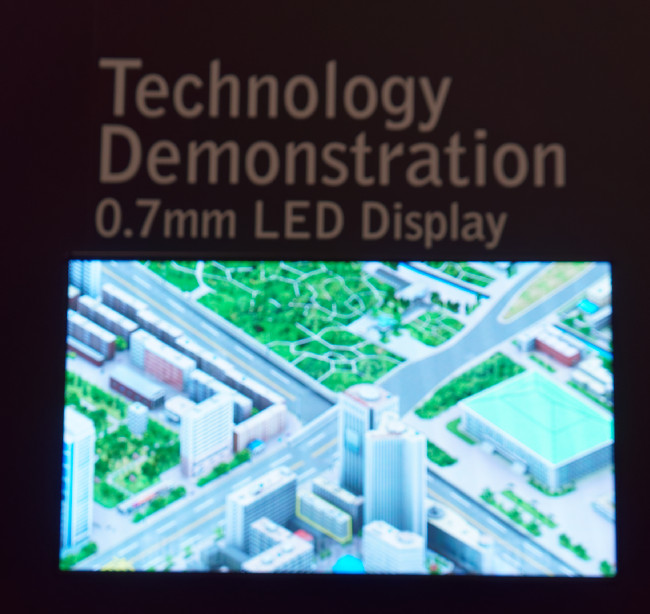 Leyard had a Prototype LED at 0.7mm
Leyard had a Prototype LED at 0.7mm
We have a separate report on the new Mitsubishi cubes (with 100,000 hour life) and its LED walls. As well as its full cubes, the company has done very well by selling upgrades of existing engines to RGB configurations. It seems that the engines can also be used in the cubes made by other brands and Mitsubishi told us that it has been somewhat surprised by how much business it has been able to pick up updating other brands. An interesting point made by the company is that in switching to LED engines, with 24/7 operation, payback can be as little as 18 months. The latest cubes have an incredibly thin bezel which is actually designed to be slightly compressed when modules are installed very close together. The company also showed a 2 x 2 LCD system on a mobile trolley that could be used as mobile emergency signage system.
Multitaction was showing its high end multi-touch, multi-user display arrays. At the show, there was no new hardware, but the company was showing new software that includes an editor and web-based CMS system that is designed to make content creation and editing easier.
Pallas showed us its 7th generation of video wall technology which has the dividers on two sides of the display and with a pitch between its LEDs of 1.8mm, now. Another new feature is that the LEDs can be programmed, which means that, for example, the joining pieces can be used to highlight a particular monitor or more. The company is still available only on 55″ panels.
 The Pallas video wall joining system is on Generation 7 now. Image:Meko
The Pallas video wall joining system is on Generation 7 now. Image:Meko
Peerless held a small press event on its booth to talk about its changes and new products. The company is investing in new ranges as well as improving its channels. It has a number of new partners and there are new partners in IT channels in France and in Germany. The company wants to innovate and has high brightness displays up to 1,500 cd/m² and products that are designed for outside use with protection up to IP68. Touch displays and support of touch-based systems will be an important part of the firm’s plans, but the main growth segment that is planned is in LED.
Peerless has a new ‘universal’ modular mounting system for LED that has full adjustment in the X, Y and Z planes and it is designed to allow access to service LED walls from the front. The system is designed so that a single component is used to fix the units from the LED supplier and Peerless has a number of these adaptors already. The system uses lightweight extrusions rather than standard sections to keep weight down.
 Peerless has a universal LED mount system. Image:Meko
Peerless has a universal LED mount system. Image:Meko
PQ Labs has the infrared touch technology that is used by a good number of brands. Its latest developments address one of the key complaints about infrared, that the frames have to protrude from the bezel. From 22mm, the company has got the bezel down to just 2mm in its latest generation of technology. It can also support up to 50 touches and can support more accurate touch. As we have previously reported, PQ is developing technology that can detect some measure of pressure by detecting the deflection of the glass. The new version is Generation 7 of the technology and pricing is still to be decided and PQ will keep its generations 5, 6 and 7 available, but with differential pricing. Gen 7 will ship in Q2 and will be compatible with Windows Ink.
Prestop is from Eindhoven in the Netherlands and was showing its range of touch displays and overlays, including one that uses the FlatFrog technology, the only overlay solution that we are aware of. The firm also has PCap technology for 32″, 42″, 55″ and 65″ but using infrared technology, it can support display systems up to 400″. The company sells direct and also through resellers and is ready to make small production runs and even ‘one offs’ that are simply not available from bigger suppliers in Asia.
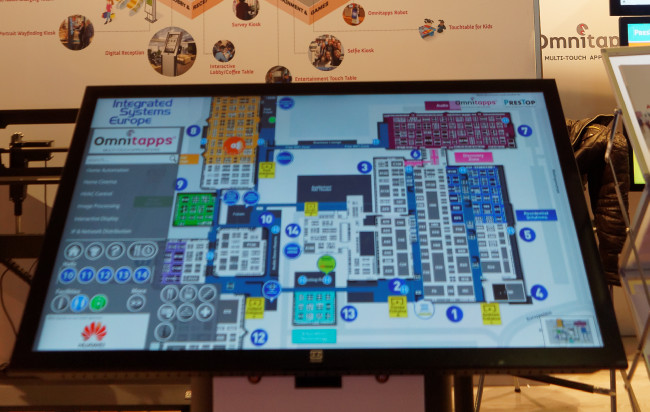 Prestop has a touch overlay using FlatFrog technology. Image:Meko
Prestop has a touch overlay using FlatFrog technology. Image:Meko
Prysm is still making its novel display cubes, but the company is continuing its pivot to become a collaboration software company. The company had no news on its own displays but said that it has now made its collaboration software work with third party displays including units from Planar and Avocor.
One of the announcements at the show was of SDVOE (Software Defined Video over Ethernet) and we met with the SDVOE Alliance which had its own booth. We spoke to staff who, in their day jobs, work for Aptovision which has been doing a lot of work to support AV over IP. We asked what the concept of SDVoE is? The answer was that the idea has been to create an API that can act as an interoperability layer, allowing software control apps to be developed without needing to understand the hardware level. This should allow lower development costs. There are lots of potential application areas including, for example, digital operating rooms in medicine. Critically, as well as some heavy A/V hitters in Sony and Christie and Netgear in networking hardware, critically Aptovision has been joined by Aquantia which has chips used in, for example, switches made by Cisco. Getting beyond a single chip supplier really raises the significance of this initiative. One of the adopters, Aurora, is using SDVoE but is calling it IPBaseT.
 RC Stars has small Android-based kiosks. Image:MekoRCStars is from China and had a number of small Android-based display systems aimed at retail applications. The company is looking for distributors in Europe. On show were 15.6″ and 24″ displays – the 24″ being a kiosk design. Moving up in size, the firm has a 27″ free-standing Android system that has a camera for face recognition. At the top of the range is the RCS-550-LBPC which has a built in PC that allows the kiosk to be used for a 3D dressing system. The sensor is mounted above the display and uses Microsoft’s Kinect technology.
RC Stars has small Android-based kiosks. Image:MekoRCStars is from China and had a number of small Android-based display systems aimed at retail applications. The company is looking for distributors in Europe. On show were 15.6″ and 24″ displays – the 24″ being a kiosk design. Moving up in size, the firm has a 27″ free-standing Android system that has a camera for face recognition. At the top of the range is the RCS-550-LBPC which has a built in PC that allows the kiosk to be used for a 3D dressing system. The sensor is mounted above the display and uses Microsoft’s Kinect technology.
Samsung Display had a meeting room to talk to clients, and had a number of panels for digital signage on display. However, there were not many innovations, with mostly incremental changes, for example the company now quotes a Tnl of 85 degrees C and contrast of 4,000:1 on its panels. Panels have also got slimmer and there was a 55″ panel that has had the thickness reduced from 9.7mm to 6.9mm. 48″ is a new size for the company, which has a 700 cd/m² FullHD panel with edge lighting that consumes just 110W.
We were surprised to see a 75″ UltraHD LCD with 600 cd/m² of brightness. Staff told us that this is likely to have been developed ‘at customer request’. Those from monitor makers that we spoke to after seeing the panel see the arrival of 600 cd/m² as confusing for the market. Up to now, there has been a clear distinction between the 500 cd/m² and 700 cd/m² classes. Having something in the middle may cause confusion.
Sim2 Multimedia had a (longer than expected) presentation (lecture?) about HDR in projection by display quality guru, Joe Kane. The company also showed a system that it developed using two separate projectors, one for the low brightness range and a second for the high brightness range. Although this is not as good as, for example, dual modulation (i.e. using an extra DLP chip to modulate the lamp), it is much simpler and the result looked pretty good to me, especially as the dynamic range of projection is inherently limited as the work by Barco and others has shown. The idea came from thinking about how audio uses tweeters and woofers to create different parts of the audio signal. Sim2 is setting up five ‘experience centres’ around the world where the concept can be seen. One is in Florida, already and the next will be in London, followed by Shanghai.
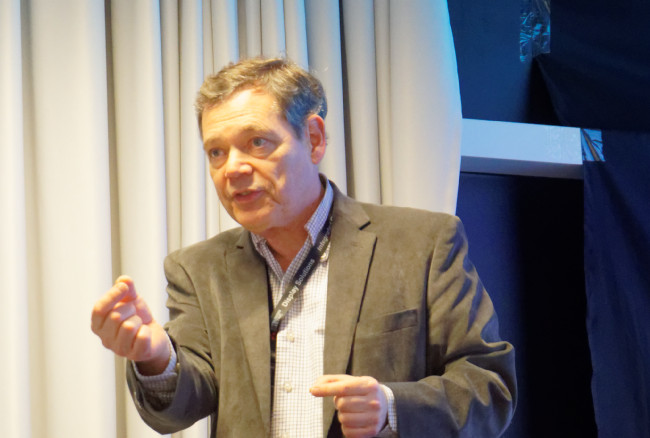 Sim2 worked with Joe Kane on a dual projector HDR system. Image:Meko
Sim2 worked with Joe Kane on a dual projector HDR system. Image:Meko
Smart Technologies was showing the same new display systems that it showed at BETT, but was highlighting the use of the systems in enterprise applications.
Teledyne LeCroy has been developing test equipment for interfaces and was showing its latest HDR testers which put the test patterns developed by Florian Friedrich and Joe Kane into a dedicated system. The company also has compliance testing for Dolby Vision and HDMI 2.0b (the version that supports signalling of HLG HDR). The HDR tests are in the QuantumData 980 model.
We mentioned to Triumph Board of the Czech Republic that we seemed to have missed the firm when we went to BETT, but it seems the company had not attended this year, preferring to wait until ISE. The firm was showing new 75″ and 86″ interactive LCDs with UltraHD resolution and 20 touch infrared. The displays will have integrated Android V5.0 and are due in two to three months, with pricing to be decided. The version of Android will be an ‘open’ one, but this has the disadvantage that non-tablet applications can be downloaded, which may not work so well. However, APK files can be uploaded simply via USB or networking.
ViewSonic had a new signage line of LCDs, the CDM range that is available in 43″, 49″ and 55″ and supports 24/7 operation. The displays are ‘smart’ and support Android 4.4.4 (5.1 coming) and will sit above the CDE range. The processor is a quad core A9 running at 1.6G (RK3188) The 55″ has a touch option.
At the show, ViewSonic was highlighting support for the new systems by Enplug software. The software is available as a cloud-based application for those that want to go to wider signage networks than traditional PC-based systems, for example in chains and QSRs. Also at the show, there was a new 86″ interactive UltraHD display that will be available at the end of Q2. The IFP8650 has 350 cd/m² of output with 1,200:1 contrast and 8ms response time. 20 touch infrared is the interaction mechanism and the display has an integrated quad core SoC with Android 5.1 and also has an OPS slot for Windows support.
The IFP7580 is a 75″ PCap display with a 360 cd/m² UltraHD IPS panel and 7H surface protection. It is available with an option motorised trolley for moving between locations. It also supports Dizmo apps which can be used for IoT and system control.
ViewSonic continues to sell projection, although the push is more towards flat panels, these days. On display at ISE was the LS830, a UST laser projector with FullHD resolution that is already shipping and that we first reported at last year’s ISE.

